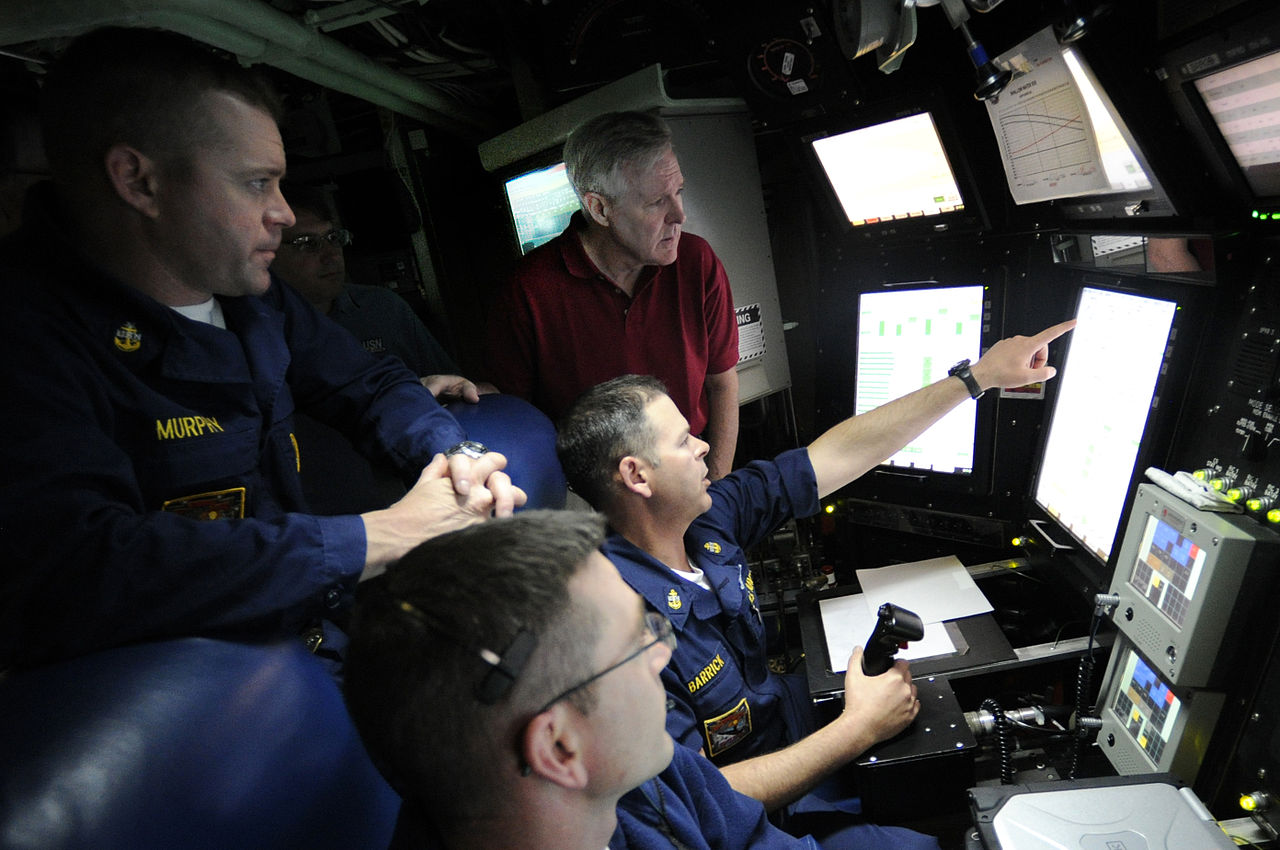When it comes to military hardware, especially of the sensitive underwater kind, once in a while a photo will pop up that shows something that you never knew existed. That was the case yesterday when Eric Moreno, founder of the popular Reddit page r/submarines, posted a picture on his Twitter account showing what appears to be a CRT navigational director display mounted in front of a conn position on the Sturgeon class nuclear fast attack submarine USS Queenfish (SSN-561). Supposedly, the photo was taken during an ICEX mission in 1970.
After seeing the photo, I asked a few of my submariner sources about it, thinking it is probably a known system that was tested or even deployed for a period of time before. That was not the response I got, none of them had ever heard of it before.

The system looks remarkably similar to the navigational display found in Grumman A-6 Intruders from the same era. That display, which was absolutely cutting-edge at the time, tied directly to the A-6’s Digital Integrated Attack Navigation Equipment (DIANE) computer system that allowed A-6 crews to make precision bombing runs during the night and in horrible weather and to navigate to and strike their targets at low-level with the aid of terrain following radar.

DIANE and other sensors and systems on the Intruder were tired to the screen, called the Vertical Display Indicator, which acted as a primary flight instrument of the pilot. The screen worked in a similar manner as modern electronic flight instrumentation systems (EFIS) with synthetic vision, but in a far cruder and self-contained manner. It could show the horizon, sky, terrain, as well as the aircraft’s altitude, angle of attack, vertical speed, and heading. A flight director was overlaid for navigation and precision bombing at night and in bad weather guided by DIANE. The display looked positively sci-fi for its time and the likeness to what we see on the CRT monitor mounted on the conn of Queenfish is very intriguing.

It doesn’t take all that much creativity to realize that such a system may have looked very appealing to submariners navigating the depths with no view of the outside world. In fact, maybe the Navy ported over some of the same technology from the A-6 and tied it into the submarine’s complex inertial navigation system (INS), sonar, and other sensors.

Whatever the story was behind this display, which looks like it belongs in an X-Wing more than a submarine from the 1960s, it had to have been leading class technology at the time. In fact, it was probably so advanced that it wasn’t even effective as we didn’t see digital conn instruments on American submarines until decades later.

It wasn’t until the Seawolf class of the 1990s that digital conn instruments would be standard class-wide. Today, the Virginia class that is currently in production has a conn that looks more like it’s installed in a starship than in a submarine.

Diverging greatly from any past design, the Virginia class jettisons the classic yoke control wheel and the vertical wall of instruments that were staples of past submarine conn stations for a pair of joysticks and a partial cocoon of angled flat panel displays. Another great photo of what this layout looks like can be seen by clicking here.

Clearly, this navigation screen mounted in USS Queenfish’s conn was way ahead of its time. Eventually the ability to process and display a slew of positioning and navigational data for sailors driving multi-billion dollar nuclear submarines would become a reality, but considering that the picture in question was supposedly shot nearly 50 years ago, it would be great to know more about just how ambitious the system shown actually was and where it came from in the first place.
If anything else, the photo is another stark reminder that America’s murky undersea warfare history still has plenty of secrets to give up.

Update: 9:10pm PST—
We have solved this mystery! The person who solved it is our own AncientSubHuntr, The War Zone discussion area’s resident anti-submarine warfare brain trust. According to AncientSubHuntr, here is what this system was, and of course it has a colorful past!:
The unexpected snap roll experienced with the leading edge technology presented by the revolutionary USS Albacore (AGSS-569) hull, among other control issues never encountered by submariners, encouraged the USN to develop and evolve a submarine control room philosophy that met these challenges. With the advent of the nuclear submarine, the incredible sustained speeds added encouragement!
The overall integration of the “faster” sonar sensors, weapons and processors with a new control philosophy was developed by Electric Boat in the late 1950s….and it was digital!! SUBIC, or SUBmarine Integrated Control, was the overall program which combined these aspects of the submarine as a modern, hydrodynamic and nuclear powered weapon system.
One evolutionary appendage of SUBIC was this visual aid to the helmsman called CONALOG (CONtact AnaLOG). CONALOG was part of the Fast-Reaction Submarine Control (FRISCO) system providing the planesman/helmsman with a “path to follow, in the form of a synthetic highway in the sea, on a CRT (the video mixer of which could also display sonar and radar information).”
Installed on the USS Shark (SSN-591) in 1961 and subsequently on USS Thresher, Permit and the Sturgeon class SSNs and the Benjamin Franklin class of SSBNs, the submariners quickly grew to hate it!”
One former submarine CO recalled that it tended to put watch-standers to sleep”…LOFL!
It was so despised, they specifically excluded it from the Los Angeles class SSN design.
AncientSubHuntr also notes that CONALOG made a cameo appearance in Ice Station Zebra, you can see it at the 25-second mark in the clip below:

Contact the author: Tyler@thedrive.com
